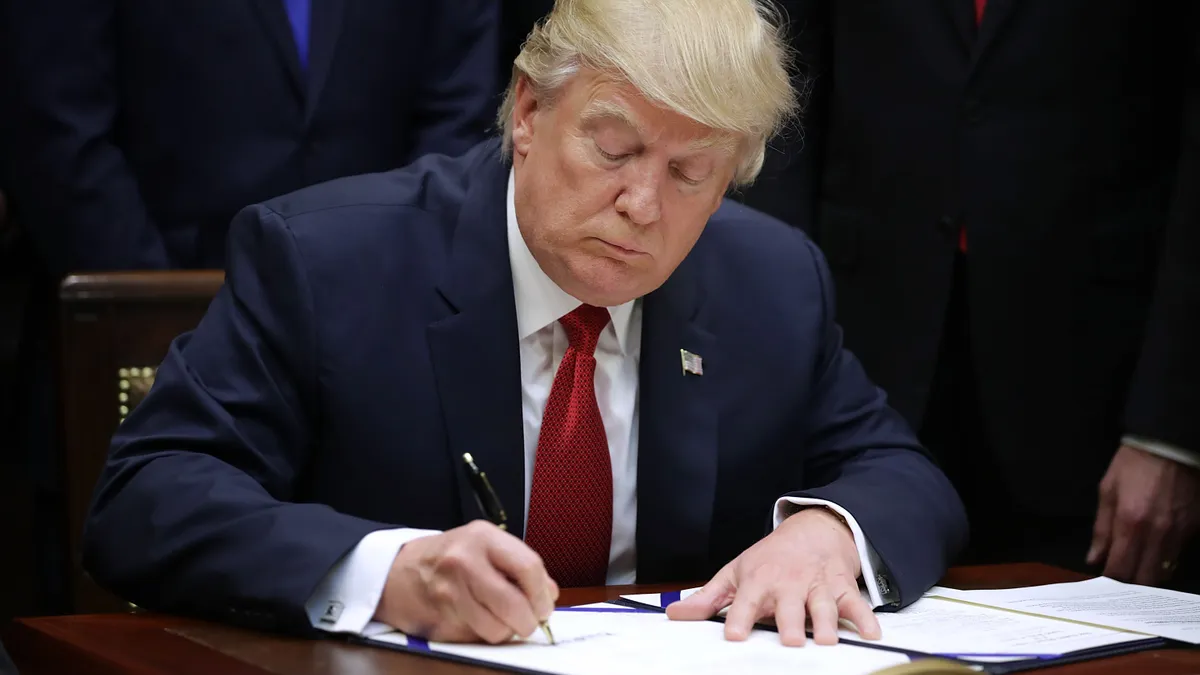Update: April 2, 2020: The House Financial Services Committee released a document April 1 with answers to frequently asked questions regarding financial services provisions of the Coronavirus Aid, Relief and Economic Security Act (CARES Act) that became law March 27. The document provides "additional information for consumers, renters, homeowners, small business owners, investors and others who may have questions about how the CARES Act will benefit them," the committee said in a statement.
Dive Brief:
- President Donald Trump March 27 signed a bill approving a $2 trillion new coronavirus relief package. After days of negotiation, the House approved the bipartisan legislation — the largest stimulus in U.S. history. The Coronavirus Aid, Relief, and Economic Security Act (CARES Act) provides small businesses and nonprofits with 500 or fewer employees almost $350 billion in partially forgivable loans. The bill will supply "$500 billion in support for hard-hit industries," Trump said, "with a ban on corporate stock buybacks."
- The legislation also included relief for individuals. Couples who earn up to $150,000 will receive $2,400, and individuals earning up to $75,000 will receive $1,200, the White House said. Both categories will receive additional $500 for each child. Those who earn more may receive smaller payments. The payments will phase out for those earning more than $75,000 ($112,500 for head of household filers and $150,000 for married couples filing joint tax returns). The White House said $100 billion will go toward the needs of healthcare providers and hospitals on "the front lines" of the pandemic.
- States will temporarily increase unemployment benefits defined as "the amount determined under the state law plus an additional amount of $600" per week to each recipient, according to the bill. States are encouraged to waive the typical one week waiting period and provide an additional 13 weeks of benefits, the White House said. A temporary pandemic unemployment assistance program will assist self-employed workers, freelancers and contractors who lost work.
Dive Insight:
The federal government’s response to the COVID-19 pandemic has included three aid packages so far. Trump first signed an emergency supplemental spending bill March 6 making available more than $7 billion in federal assistance to government health officials and to support the development of a vaccine. He also signed the Families First Coronavirus Response Act March 18, which expanded family and medical leave and guaranteed paid sick leave for certain U.S. workers.
At a time when Americans are practicing social distancing at the instruction of the Centers for Disease Control and Prevention, telehealth or virtual care was made a priority in the CARES Act. The measure allows for high-deductible health plans (HDHPs) with a health savings account (HSA) to cover telehealth services prior to a patient reaching the deductible. The Internal Revenue Service announced March 11 that HDHPs can pay for 2019 COVID-19-related testing and treatment, without jeopardizing their status. "Now with the latest IRS notice allowing the waiving of the need to satisfy the deductible for COVID-19 testing or treatment for those with HSA plan coverage, they too are likely to be able to access telehealth without cost for COVID-19 related reasons," Steve Wojcik, vice president, public policy at the Business Group on Health, recently told HR Dive in an emailed statement.
These changes come as Fortune 500 companies such as Amazon expand pilots of telehealth. The company announced in February that in its Seattle headquarters it would offer employees and their families increased access to live chat or video services with a doctor or nurse practitioner. Jeff Levin-Scherz, North American co-leader of Willis Towers Watson's health management practice, told HR Dive in a recent interview that many companies emphasize the availability of telehealth as the solution generally has lower associated costs and out-of-pocket costs compared to in-office care.
As with healthcare, lawmakers focused on decreasing the expenses of Americans financially affected by the COVID-19 pandemic. The CARE Act provides a grace period for federal student loan borrowers. Under the bill, borrowers are not required to make payment for six months, and no interest will accumulate. Employers also have the opportunity to receive a student loan tax break. IRS Code 127 was amended to allow employers to pay workers up to $5,250 per year on a tax-free basis for student loan debt expenses. Employees wouldn't have to include the funds as income.
The CARES Act also expanded the eligibility for small business loans under section 7 of the Small Business Act to help employers cover payroll costs. And, businesses impacted by COVID-19 are eligible for a tax credit of $5,000 for wages paid to each employee, the White House said.













